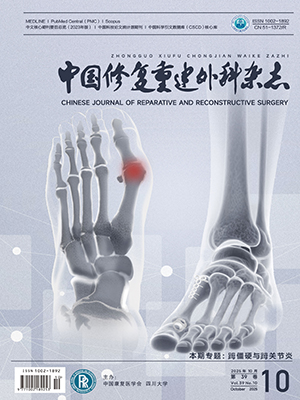| 1. |
Bäcker HC, Vosseller JT, Deml MC, et al. Spinopelvic dissociation: A systematic review and meta-analysis. J Am Acad Orthop Surg, 2021, 29(4): e198-e207.
|
| 2. |
Morris CA, Moo Young JP, Savakus JC, et al. Neurologic injury after spinopelvic dissociation: Incidence, outcome, and predictors. Injury, 2023, 54(2): 615-619.
|
| 3. |
Hirschfeld M, Pascual-López FJ, Guerado E. Spinopelvic dissociation: Current concepts. Rev Esp Cir Ortop Traumatol, 2024, 68(4): 398-408.
|
| 4. |
Purser DW. Displaced fracture of the sacrum. Report of a case. J Bone Joint Surg (Br), 1969, 51(2): 346-347.
|
| 5. |
Bents RT, France JC, Glover JM, et al. Traumatic spondylopelvic dissociation. A case report and literature review. Spine (Phila Pa 1976), 1996, 21(15): 1814-1819.
|
| 6. |
Park YS, Baek SW, Kim HS, et al. Management of sacral fractures associated with spinal or pelvic ring injury. J Trauma Acute Care Surg, 2012, 73(1): 239-242.
|
| 7. |
Moo Young JP, Savakus JC, Obey MR, et al. Lumbopelvic fixation in the treatment of spinopelvic dissociation: union, complications, and neurologic outcomes of a multicenter case series. Eur J Orthop Surg Traumatol, 2024, 34(5): 2391-2396.
|
| 8. |
Voort WV, O’Donnell E, Haffner M, et al. Biomechanical analysis of a modified triangular osteosynthesis technique for treatment of spinopelvic dissociation. J Orthop Trauma, 2024, 38(11S): S35-S39.
|
| 9. |
Quacinella MA, Morrissey PB, Parry JA, et al. Spinopelvic dissociation: assessment, reduction strategies, and fixation techniques. J Am Acad Orthop Surg, 2020, 28(24): e1086-e1096.
|
| 10. |
Roy-Camille R, Saillant G, Gagna G, et al. Transverse fracture of the upper sacrum. Suicidal jumper’s fracture. Spine (Phila Pa 1976), 1985, 10(9): 838-845.
|
| 11. |
Strange-Vognsen HH, Lebech A. An unusual type of fracture in the upper sacrum. J Orthop Trauma, 1991, 5(2): 200-203.
|
| 12. |
Gibbons KJ, Soloniuk DS, Razack N. Neurological injury and patterns of sacral fractures. J Neurosurg, 1990, 72(6): 889-893.
|
| 13. |
Zhao P, Wang X, Chen X, et al. Preoperative CT simulation of iliosacral screws for treating unstable posterior pelvic ring injury. BMC Musculoskelet Disord, 2022, 23(1): 220. doi: 10.1186/s12891-022-05155-6.
|
| 14. |
Matta JM, Tornetta P. Internal fixation of unstable pelvic ring injuries. Clin Orthop Relat Res, 1996(329): 129-140.
|
| 15. |
Majeed SA. Grading the outcome of pelvic fracture. J Bone Joint Surg (Br), 1989, 71(2): 304-306.
|
| 16. |
Santolini E, Kanakaris NK, Giannoudis PV. Sacral fractures: issues, challenges, solutions. EFORT Open Rev, 2020, 5(5): 299-311.
|
| 17. |
Godolias P, Plümer J, Cibura C, et al. Posterior pelvic ring injuries, lumbosacral junction instabilities and stabilization techniques for spinopelvic dissociation: a narrative review. Arch Orthop Trauma Surg, 2024, 144(4): 1627-1635.
|
| 18. |
Matsugaki T, Shibata H, Esaki Y, et al. Suicidal jumper’s fracture reduced with hyperextension and the joystick method: A case report. Trauma Case Rep, 2021, 32: 100444. doi: 10.1016/j.tcr.2021.100444.
|
| 19. |
Ruatti S, Kerschbaumer G, Gay E, et al. Technique for reduction and percutaneous fixation of U- and H-shaped sacral fractures. Orthop Traumatol Surg Res, 2013, 99(5): 625-629.
|
| 20. |
Chou DTS, El-Daly I, Ranganathan A, et al. Spinopelvic dissociation: A retrospective case study and review of treatment controversies. J Am Acad Orthop Surg, 2018, 26(14): e302-e312.
|
| 21. |
Williams SK, Quinnan SM. Percutaneous lumbopelvic fixation for reduction and stabilization of sacral fractures with spinopelvic dissociation patterns. J Orthop Trauma, 2016, 30(9): e318-e324.
|
| 22. |
Gross A, Kuttner H, Shariat K, et al. The surgical management of highly unstable fragility fractures of the sacrum with spinopelvic dissociation: A case series and proposal of a surgical treatment algorithm. Injury, 2022, 53(10): 3377-3383.
|
| 23. |
Chen W, Hou Z, Su Y, et al. Treatment of posterior pelvic ring disruptions using a minimally invasive adjustable plate. Injury, 2013, 44(7): 975-980.
|
| 24. |
张银光, 贾健, 刘兆杰. 髂腰内固定治疗创伤性脊柱骨盆分离. 中华骨科杂志, 2015, 35(4): 328-334.
|
| 25. |
Romoli S, Petrella L, Becattini E, et al. Treatment of unstable spinopelvic fractures: outcome of three surgical techniques-a retrospective single-center case series. Eur Spine J, 2023, 32(1): 93-100.
|
| 26. |
Tian W, Chen WH, Jia J. Traumatic spino-pelvic dissociation with bilateral triangular fixation. Orthop Surg, 2018, 10(3): 205-211.
|
| 27. |
Brodell JD, Lawlor MC, Santangelo G, et al. Percutaneous lumbopelvic fixation is effective in the management of unstable transverse sacral fractures. Injury, 2024, 55(11): 111825. doi: 10.1016/j.injury.2024.111825.
|
| 28. |
Kaye ID, Yoon RS, Stickney W, et al. Treatment of spinopelvic dissociation: A critical analysis review. JBJS Rev, 2018, 6(1): e7. doi: 10.2106/JBJS.RVW.16.00119.
|
| 29. |
郑博隆, 庄岩, 袁雷红, 等. 影响骶管减压髂腰固定治疗“H”形骶骨骨折疗效的相关因素分析. 中华骨科杂志, 2017, 37(13): 810-816.
|




